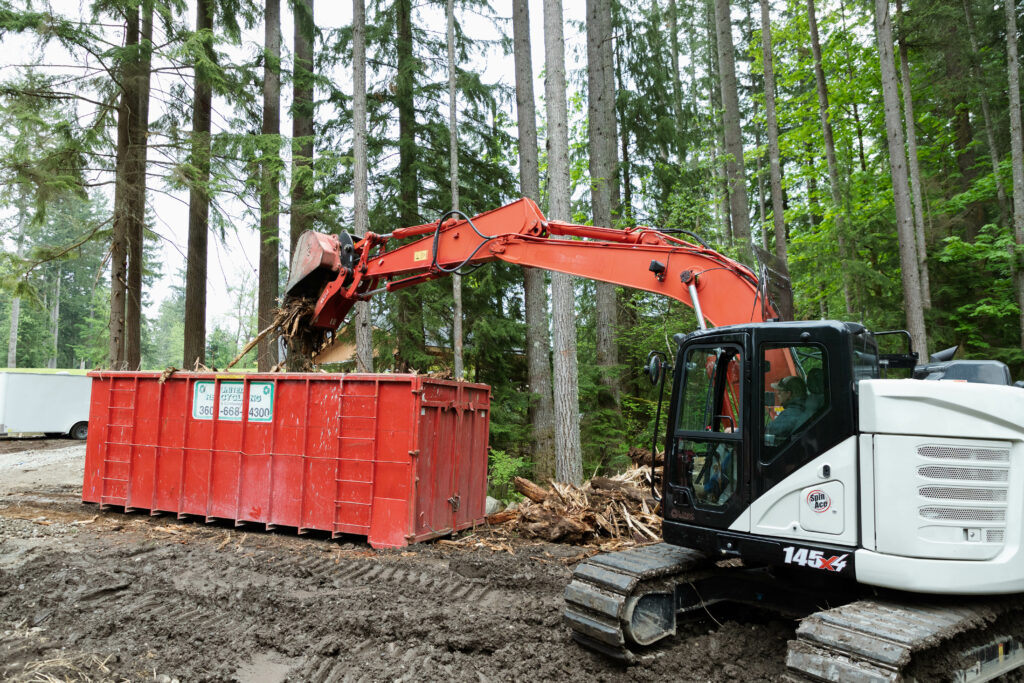Your land will greatly determine what kind of structure you can build, and where. There are many factors that come into play here, and before you can start the excitement of construction, there is work to be done on the ground level.
The excavation company that you work with will be a great resource to guide you through this process and answer any questions you may have along the way.

Outline
Below you will learn about the six main steps to preparing your land for construction
- Permitting, building design and layout
- Clearing your land
- Testing your soil
- Preparing your foundation
- Pouring your foundation
- Running your utilities
Building Details and Permitting: Layout, Design, Access and Utilities
The first place to start is a feasibility report of your land. This is essentially a step in the permitting process, which is needed both before you can start clearing/ prepping your land and before starting your construction. The feasibility of your land will confirm what kind of structure your land can support, and where it can be built. This takes into account the location of necessary access roads or driveways, where utilities will run, any wetlands or critical areas on your property, and where septic systems will be installed if included in your building plan. Contact your local building authority for information about the land clearing and building permitting process to get started. Learn more about the building permit process and what you can expect here.
Land Clearing
Once you have your building plan approved and your permits in hand, your land can be cleared of all organic materials. All trees and brush will be cleared and the locations of your foundation, access roads and driveways, and places to store equipment and material will be set. Now your land is almost ready to build upon.
It’s important to note that the organic material cleared from your land will often need to be hauled away. The excavation company that does the clearing generally can coordinate this, but it will be an additional cost to anticipate in your budget.

Test Your Soil
After your land is cleared you will test your soil to ensure it can support your structure, access roads and driveways and utilities. The excavation company that you work with may be able to help schedule a geotechnical assessment with an engineer for this step. Factors such as the depth of water tables, and the composition of the soil will be tested and then accounted for by the excavation company.
Common occurrences that come from soil tests include:
- The quality of soil and depth of bearing soil
- Water table depth
Bearing soil is soil that can support your structure foundation, access roads and driveways and utilities. If the depth of bearing soil on your land is too deep, or buried beneath bad soil, the excavation crew will remove the bad soil and replace it with crushed rock to provide the proper support and drainage for the structure foundation and access. Like the organic material cleared from your site, any bad soil that is extracted will need to be hauled off. Your excavation company will coordinate this.
If the water table on your land is too close to the surface, the excavation crew will again remove the soil beneath it and replace it with crushed rock to account for the water and support the foundation of your structure and any roads/ driveways.
Prepare Your Foundation
Now that your build site is cleared, your access roads and driveways are cut in and supported, and the soil has been assessed and prepped to support your structure, your building pad will be prepared. This is where your foundation will be set.
Often building sites appear flat, but in most cases they are between 2 and 10 feet off from level. If this is the case, the excavation crew will level your building site by bringing in dirt from other areas of your property (if bearing soil is accessible) or they will bring in additional dirt via dump trucks. Dirt is not free, so this is another expense to anticipate in the budgeting of your project.
Pour Your Foundation
With a level building pad for the foundation of your structure, concrete can be poured for either traditional stem wall foundations, or post-in-ground.

Run Utilities
After the foundation is poured and the concrete is set, the utilities can be pulled to the building location (gas,water,septic/sewer, and communications.)
Conclusion
At this point your land has been assessed and all of the necessary support for the foundation and access have been addressed. Congratulations, you’re ready to start building!
POPULAR
Planning Checklist: How to Prepare to Build a Barn


The Building Permit Process: Cost, Timeline and What to Expect

Understanding Post Frame Structure Construction




